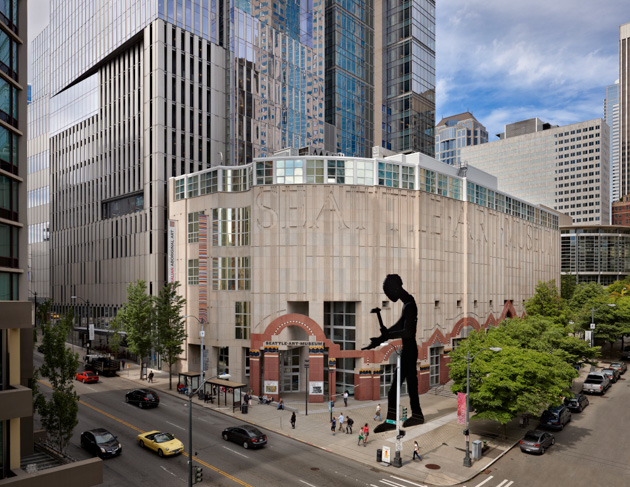[ad_1]

The Seattle Art Museum, designed by Venturi, Scott Brown & Associates, which opened in 1991.
SEATTLE ART MUSEUM
Robert Venturi, the freethinking architect who famously answered Ludwig Mies van der Rohe’s dictum that “less is more” with the quip “less is a bore,” has died at the age of 93. In a statement, his family said that he had recently been ill.
Over the course of a career that spanned more than 50 years, Venturi mounted a sustained counterattack on the high seriousness of modernism, praising the vernacular, the commercial, and even the avowedly ordinary in writings and buildings that he often produced in collaboration with his wife, Denise Scott Brown. The two met in 1960 when they were both teaching at the University of Pennsylvania in Philadelphia and married in 1967. Together, they were pivotal in ushering postmodernism into their field.
“We were calling for an architecture that promotes richness and ambiguity over unity and clarity, contradiction and redundancy over harmony and simplicity,” Venturi once said, articulating the sensibilities that came to define his and Scott Brown’s firm, now known as VSBA—an abbreviation of Venturi, Scott Brown and Associates. Venturi retired in 2016; Scott Brown, who is 86, continues to present new work.
Throughout the firm’s practice one finds witty, even whimsical, uses of historical tropes, with elements blown up, stuck together, or both. In a key early example—the Vanna Venturi House, designed for his mother in 1964, in Chestnut Hill, Pennsylvania—the top of a trapezoidal facade slopes up at a sharp angle with a chimney shape popping up behind and variously sized windows dotting its front. The design imparts an approach to space that is generous, confident, and not overly serious—irreverent and almost jaunty in its shrugging off of high modernist strictures.
Among the many projects designed by VSBA were the Museum of Contemporary Art in San Diego, which opened in 1996; the Seattle Art Museum, in 1991; an addition to the Allen Memorial Art Museum in Oberlin, Ohio, in 1976; and the Sainsbury wing of the National Gallery of Art in London, also in 1991. The architecture critic Paul Goldberger termed the latter “a dazzling play on classicism, richly detailed, spatially intricate, and in every way consistent with the long and honorable English tradition of idiosyncratic inventions within the classical language of architecture.”
The contrarian approach favored by Venturi and Scott Brown did not endear them to many in their profession. “Almost everything that the Venturis have to say is heresy, if you have been brought up as a true believer in modern architectural doctrine as formulated in the early part of this century,” as Ada Louise Huxtable put it in 1971. With her characteristic flourish, she argued that their “work is eye-opening and catalytic and if my response is complex and contradictory, so are the Venturis, and life, and art.” (Huxtable also once dubbed Venturi “the guru of chaos.”)
Venturi’s iconoclastic ideas first attracted widespread attention in Complexity and Contradiction in Architecture, a “gentle manifesto,” as he termed it, published in 1966. The work famously asks: “Is not Main Street almost all right?” With Steven Izenour, the couple published the piquantly titled Learning from Las Vegas in 1972, the result of trips they made with graduate students from Yale University to Sin City to study its layout and architecture. (The couple’s favorite place to stay, Goldberger reported in a rollicking 1971 newspaper profile of Venturi, was the Tropicana, though they were not ones to gamble.)
In their attention to—and outright admiration for—the exuberant aesthetics of postwar American abundance, Venturi and Scott Brown found common cause with Pop artists like Andy Warhol, Roy Lichtenstein, and James Rosenquist, who at times reveled in such material, and their work sometimes channeled the look of those figures, as in their design in the 1970s for a Best Products showroom that was paneled with a pattern of loosely drawn flowers. Part of that design now resides at the Museum of Modern Art in New York.
Venturi was born in Philadelphia in 1925. His father was a fruit merchant. He attended Princeton University, spent two years working in the office of architect Eero Saarinen in New York, spent some time managing his family’s successful fruit business, and then decamped to Rome after earning a place at the American Academy, before returning to the States to work for Louis Kahn.
His experience in the Italian capital was formative, with the city’s heady admixture of grand architecture and more quotidian buildings, carefully planned avenues and millennia-old alleys. “No one is happier in Rome than Bob Venturi,” Venturi told Goldberger in 1971. Goldberger reported that a slogan displayed in a Whitney Museum show that same year, devoted to the firm Venturi & Rausch (an earlier iteration of VSBA) read, “Symbol in space before form in space. Las Vegas is to the Strip what Rome is to the Piazza.”
Venturi received many of his profession’s major awards, including its highest, the Pritzker Prize, in 1991, though the omission of Denise Brown in the bestowing of that honor led to accusations of sexism and calls for the citation to be amended. In 2016, the American Institute of Architects conferred its Gold Medal on them together, the first time the award had gone to more than one person jointly.
Nearly 60 years after their meeting, the influence of Venturi and Scott Brown remains profound, visible in any building, architectural idea, or even artistic pursuit that favors sui generis solutions and pastiche over rigid orthodoxies, and that approaches the full span of history with a sense of reverence tempered by a commitment to play.
“I am for messy vitality over obvious unity,” a very contemporary-sounding passage in Complexity and Contradiction in Architecture reads. “I include the non sequitur and proclaim the duality. I am for richness of meaning rather than clarity of meaning.”
[ad_2]
Source link

